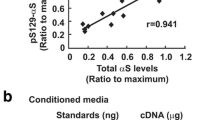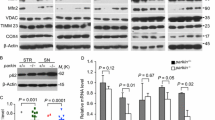Abstract
Tyrosine hydroxylase (TH) is a rate-limiting enzyme for the biosynthesis of catecholamines including dopamine. The relationship between proteasomal dysfunction and the etiology of Parkinson’s disease has been suggested, but it is unknown if TH protein is affected by proteasomal dysfunctions. Here, we examined the effect of inhibition of ubiquitin–proteasomal pathway on biochemical characteristics of TH protein in the neuronal cells. Inhibition of 20S or 26S proteasome by proteasome inhibitor I, or MG-132 in NGF-differentiated PC12D cells induced dot-like immunoreactivities with the anti-40Ser-phosphorylated TH (p40-TH) antibody. These dots were tightly co-localized with ubiquitin and positive to Thioflavine-S staining. These dot-like immunoreactivities were not obvious when immunostaining was performed against total-TH or choline acetyltransferase. Western blotting analysis showed time-dependent increase of p40-TH in the Triton-insoluble fractions. We also examined the effect of okadaic acid, an inhibitor of protein phosphatase 2A, which is a phosphatase acting on p40-TH. Okadaic acid increased the amount of insoluble p40-TH. These data suggest that p40-TH is prone to be insolubilized and aggregated by dysfunction of an ubiquitin–proteasome system in PC12D cells.




Similar content being viewed by others
Abbreviations
- ChAT:
-
Choline acetyltransferase
- DA:
-
Dopamine
- NGF:
-
Nerve growth factor
- OA:
-
Okadaic acid
- PD:
-
Parkinson’s disease
- PKA:
-
Cyclic AMP-dependent protein kinase (protein kinase A)
- PP2A:
-
Protein phosphatase 2A
- TH:
-
Tyrosine hydroxylase
- p40-TH:
-
Tyrosine hydroxylase phosphorylated at 40Ser
References
Carrard G, Bulteau AL, Petropoulos I, Friguet B (2002) Impairment of proteasome structure and function in aging. Int J Biochem Cell Biol 34:1461–1474
Daubner SC, Lauriano C, Haycock JW, Fitzpatrick PF (1992) Site-directed mutagenesis of serine 40 of rat tyrosine hydroxylase. J Biol Chem 267:12639–12646
Døskeland AP, Flatmark T (2002) Ubiquitination of soluble and membrane-bound tyrosine hydroxylase and degradation of the soluble form. Eur J Biochem 269:1561–1569
Dunkley PR, Bobrovskaya L, Graham ME, Nagy-Felsobuki EI, Dickson PW (2004) Tyrosine hydroxylase phosphorylation: regulation and consequences. J Neurochem 91:1025–1043
Fujisawa H, Okuno S (2005) Regulatory mechanism of tyrosine hydroxylase activity. Biochem Biophys Res Commun 338:271–276
Haavik J, Schelling DL, Campbell DG, Andersson KK, Flatmark T, Cohen P (1989) Identification of protein phosphatase 2A as the major tyrosine hydroxylase phosphatase in adrenal medulla and corpus striatum: evidence from the effects of okadaic acid. FEBS Lett 251:36–42
Haycock JW (1990) Phosphorylation of tyrosine hydroxylase in situ at serine 8, 19, 31, and 40. J Biol Chem 265:11682–11691
Haycock JW, Haycock DA (1991) Tyrosine hydroxylase in rat brain dopaminergic nerve terminals. J Biol Chem 266:5650–5657
Katoh-Semba R, Kitajima S, Yamazaki Y, Sano M (1987) Neuritic growth from a new subline of PC12 pheochromocytoma cells: cyclic AMP mimics the action of nerve growth factor. J Neurosci Res 17:36–44
Kawahata I, Yagishita S, Hasegawa K, Natatsu I, Nagatsu T, Ichinose H (2009) Immunohistochemical analyses of human brain-stem type Lewy bodies and the localization of phosphorylated tyrosine hydroxylase in the midbrain. Biogenic Amines (in press)
Keller JN, Gee J, Ding Q (2002) The proteasome in brain aging. Ageing Res Rev 1:279–293
Kuljis RO, Martín-Vasallo P, Peress NS (1989) Lewy bodies in tyrosine hydroxylase-synthesizing neurons of the human cerebral cortex. Neurosci Lett 20:49–54
Le Bourdellès B, Horellou P, Le Caer JP, Denèfle P, Latta M, Haavik J, Guibert B, Mayaux JF, Mallet J (1991) Phosphorylation of human recombinant tyrosine hydroxylase isoforms 1 and 2: an additional phosphorylated residue in isoform 2, generated through alternative splicing. J Biol Chem 266:17124–17130
Leal RB, Sim AT, Gonçalves CA, Dunkley PR (2002) Tyrosine hydroxylase dephosphorylation by protein phosphatase 2A in bovine adrenal chromaffin cells. Neurochem Res 27:207–213
Maroteaux L, Campanelli JT, Scheller RH (1988) Synuclein: a neuron-specific protein localized to the nucleus and presynaptic nerve terminal. J Neurosci 8:2804–2815
McNaught KS, Olanow CW (2003) Proteolytic stress: a unifying concept for the etiopathogenesis of Parkinson’s disease. Ann Neurol 53(Suppl. 3):73–86
McNaught KS, Olanow CW, Halliwell B, Isacson O, Jenner P (2001) Failure of the ubiquitin–proteasome system in Parkinson’s disease. Nat Rev Neurosci 2:589–594
Nagatsu T, Levitt M, Udenfriend S (1964) Tyrosine hydroxylase the initial step in norepinephrine biosynthesis. J Biol Chem 239:2910–2917
Nakashima S, Ikuta F (1984) Tyrosine hydroxylase protein in Lewy bodies of parkinsonian and senile brains. J Neurol Sci 66:91–96
Nakashima A, Hayashi N, Kaneko YS, Mori K, Egusa H, Nagatsu T, Ota A (2005) Deletion of N-terminus of human tyrosine hydroxylase type 1 enhances stability of the enzyme in AtT-20 cells. J Neurosci Res 81:110–120
Okuno S, Fujisawa H (1985) A new mechanism for regulation of tyrosine 3-monooxygenase by end product and cyclic AMP dependent protein kinase. J Biol Chem 260:2633–2635
Royo M, Fitzpatrick PF, Daubner SC (2005) Mutation of regulatory serines of rat tyrosine hydroxylase to glutamate: effects on enzyme stability and activity. Arch Biochem Biophys 434:266–274
Spillantini MG, Schmidt ML, Lee VM, Trojanowski JQ, Jakes R, Goedert M (1997) α-Synuclein in Lewy bodies. Nature 388:839–840
Spillantini MG, Crowther RA, Jakes R, Hasegawa M, Goedert M (1998) α-Synuclein in filamentous inclusions of Lewy bodies from Parkinson’s disease and dementia with Lewy bodies. Proc Natl Acad Sci USA 95:6469–6473
Ueda K, Fukushima H, Masliah E, Xia Y, Iwai A, Yoshimoto M, Otero DA, Kondo J, Ihara Y, Saitoh T (1993) Molecular cloning of cDNA encoding an unrecognized component of amyloid in Alzheimer disease. Proc Natl Acad Sci USA 90:11282–11286
Urano F, Hayashi N, Arisaka F, Kurita H, Murata S, Ichinose H (2006) Molecular mechanism for pterin-mediated inactivation of tyrosine hydroxylase: formation of insoluble aggregates of tyrosine hydroxylase. J Biochem 139:625–635
Wersinger C, Sidhu A (2002) Inflammation and Parkinson’s disease. Curr Drug Targets Inflamm Allergy 1:221–242
Zhang NY, Tang Z, Liu CW (2008) α-Synuclein protofibrils inhibit 26 S proteasome-mediated protein degradation: understanding the cytotoxicity of protein protofibrils in neurodegenerative disease pathogenesis. J Biol Chem 283:20288–20298
Acknowledgments
This work was supported by the Research Grant (18A-2) for Nervous and Mental Disorders from the Ministry of Health, Labor and Welfare of Japan; by grants from the Ministry of Education, Culture, Sports, Science, and Technology of Japan; and by JST, CREST.
Author information
Authors and Affiliations
Corresponding author
Electronic supplementary material
Below is the link to the electronic supplementary material.
702_2009_304_MOESM1_ESM.tif
Supplement Fig. 1. Images with lower magnification for Fig. 1A. All the cells were differentiated with 50 ng/mL NGF for 7 days and exposed to 250 nM MG-132 for indicated hours. Scale bars, 10 μm (TIFF 593 kb)
702_2009_304_MOESM2_ESM.tif
Supplement Fig. 2. Effect of proteasome Inhibitor I (PSI) on p40-TH aggregate formation. PC12D cells are differentiated with 50 ng/ml NGF for 7 days and exposed to PSI for indicated hours, and immunostained with primary antibodies against p40-TH and ubiquitin. 20S proteasomal inhibition induced formation of p40-TH immunoreactive cytoplasmic aggregates, which were similar to MG-132 treated ones. Control, vehicle treatment (DMSO). Scale bar, 10 μm for all images (TIFF 763 kb)
Rights and permissions
About this article
Cite this article
Kawahata, I., Tokuoka, H., Parvez, H. et al. Accumulation of phosphorylated tyrosine hydroxylase into insoluble protein aggregates by inhibition of an ubiquitin–proteasome system in PC12D cells. J Neural Transm 116, 1571–1578 (2009). https://doi.org/10.1007/s00702-009-0304-z
Received:
Accepted:
Published:
Issue Date:
DOI: https://doi.org/10.1007/s00702-009-0304-z




